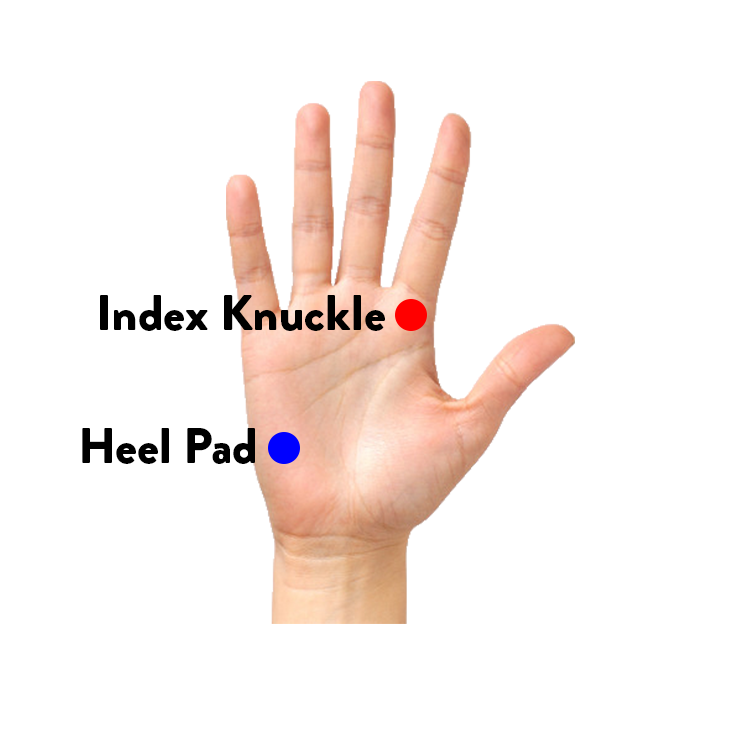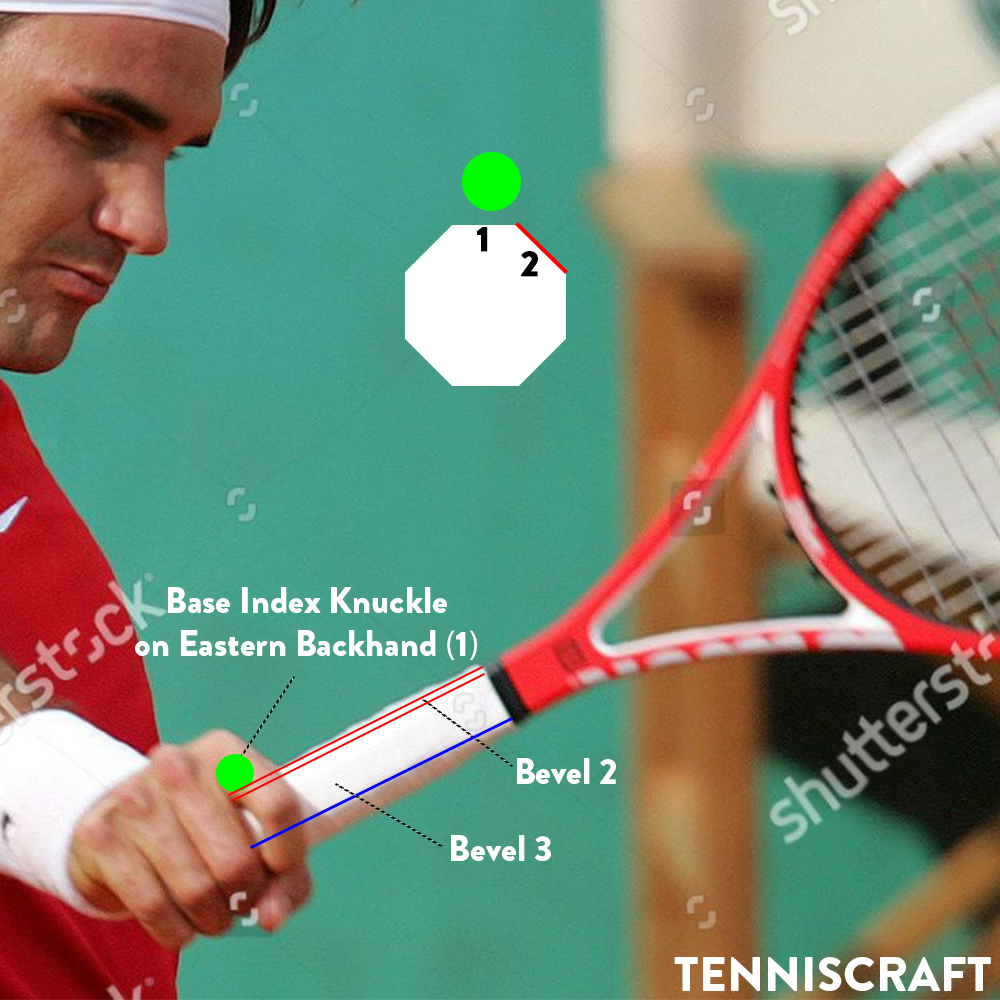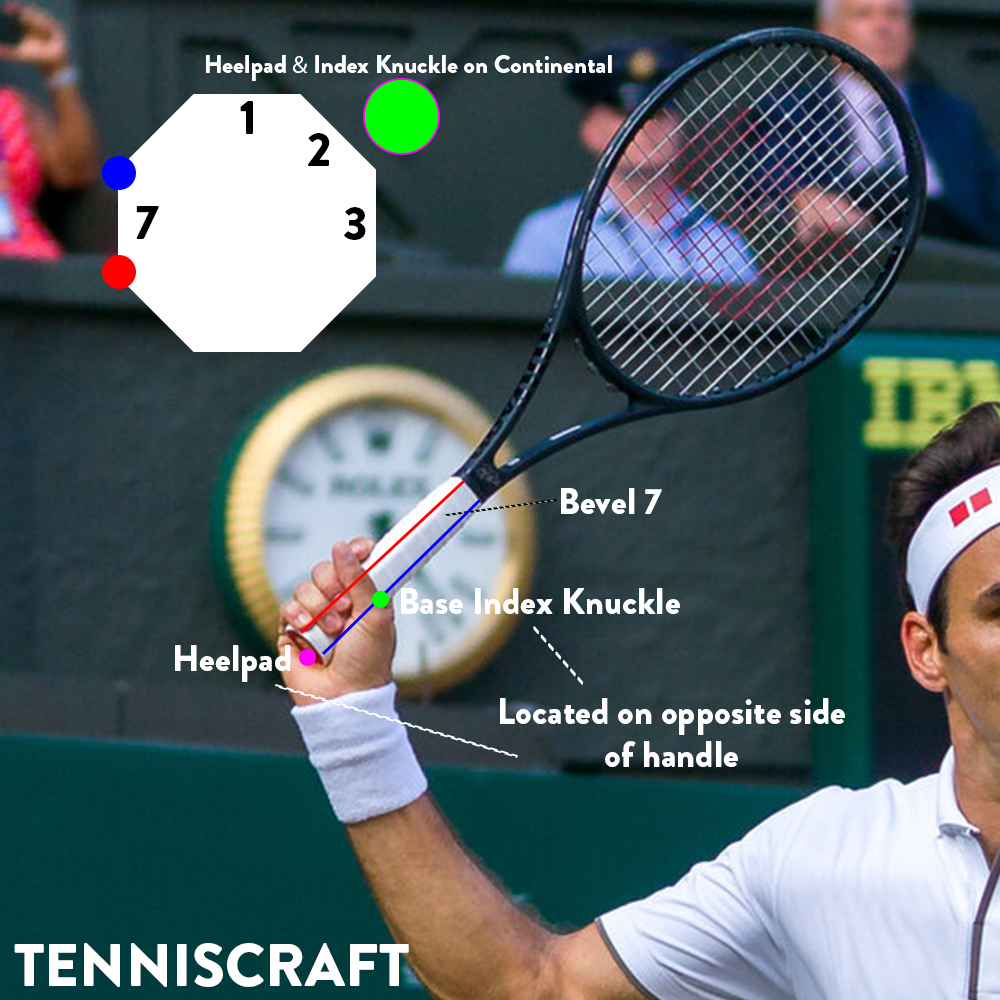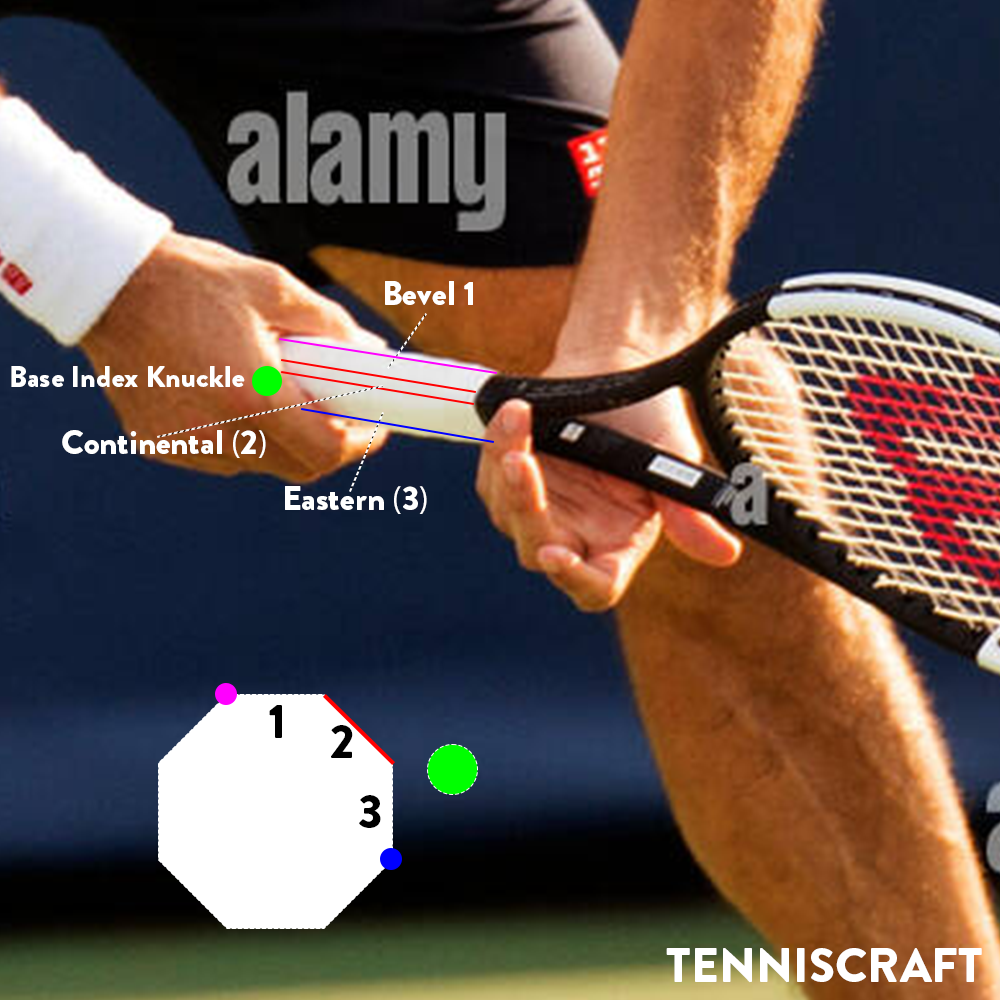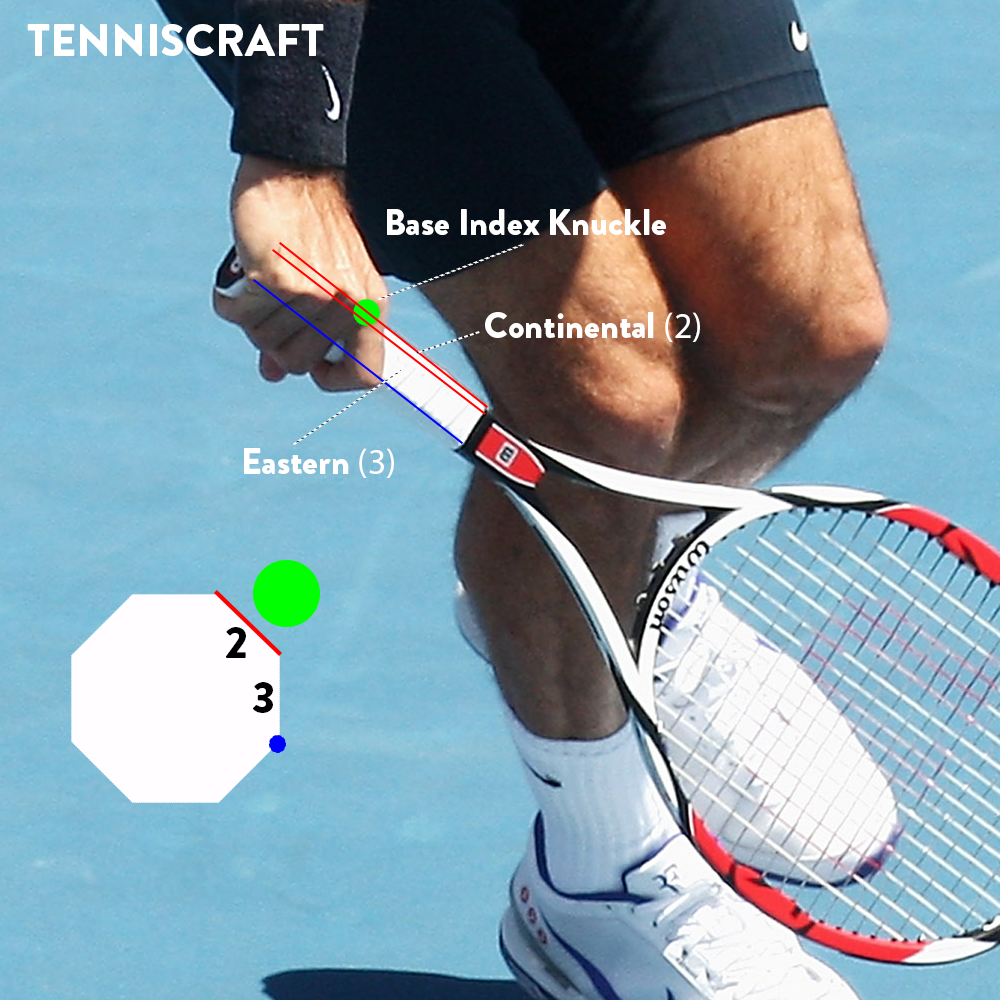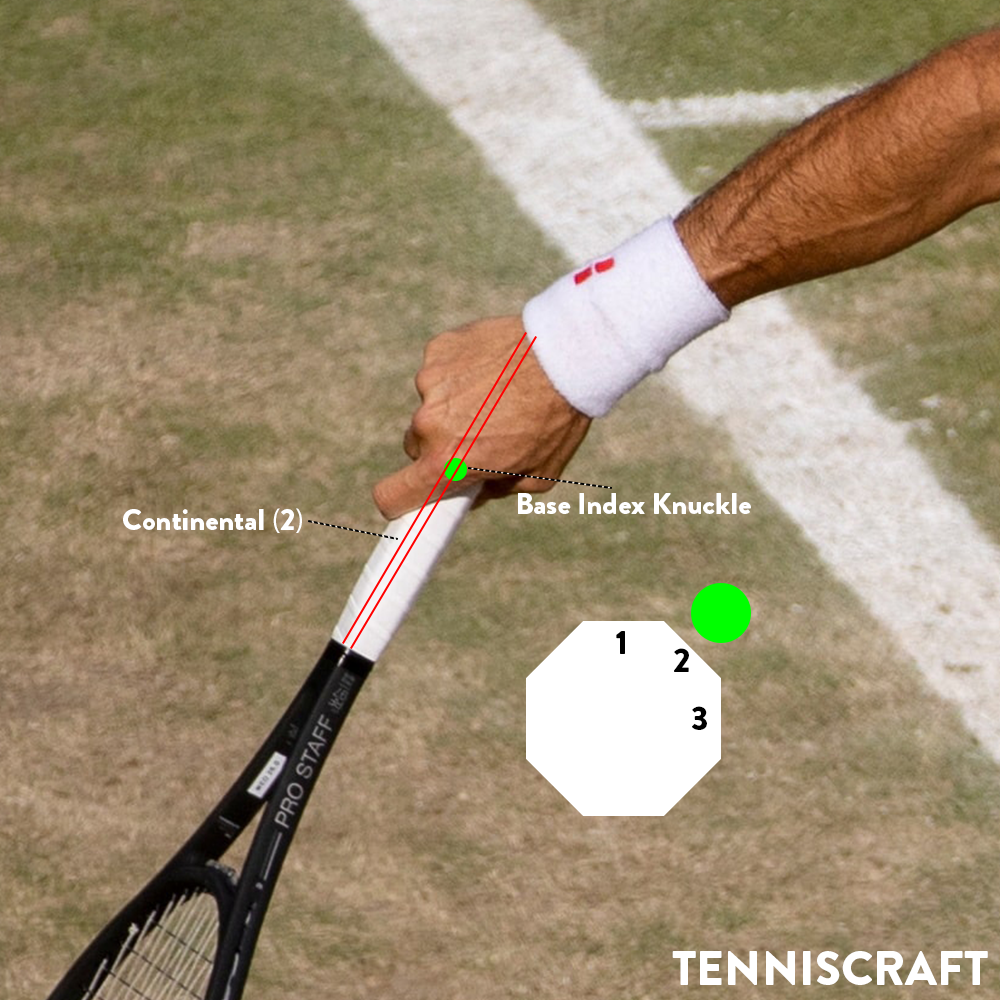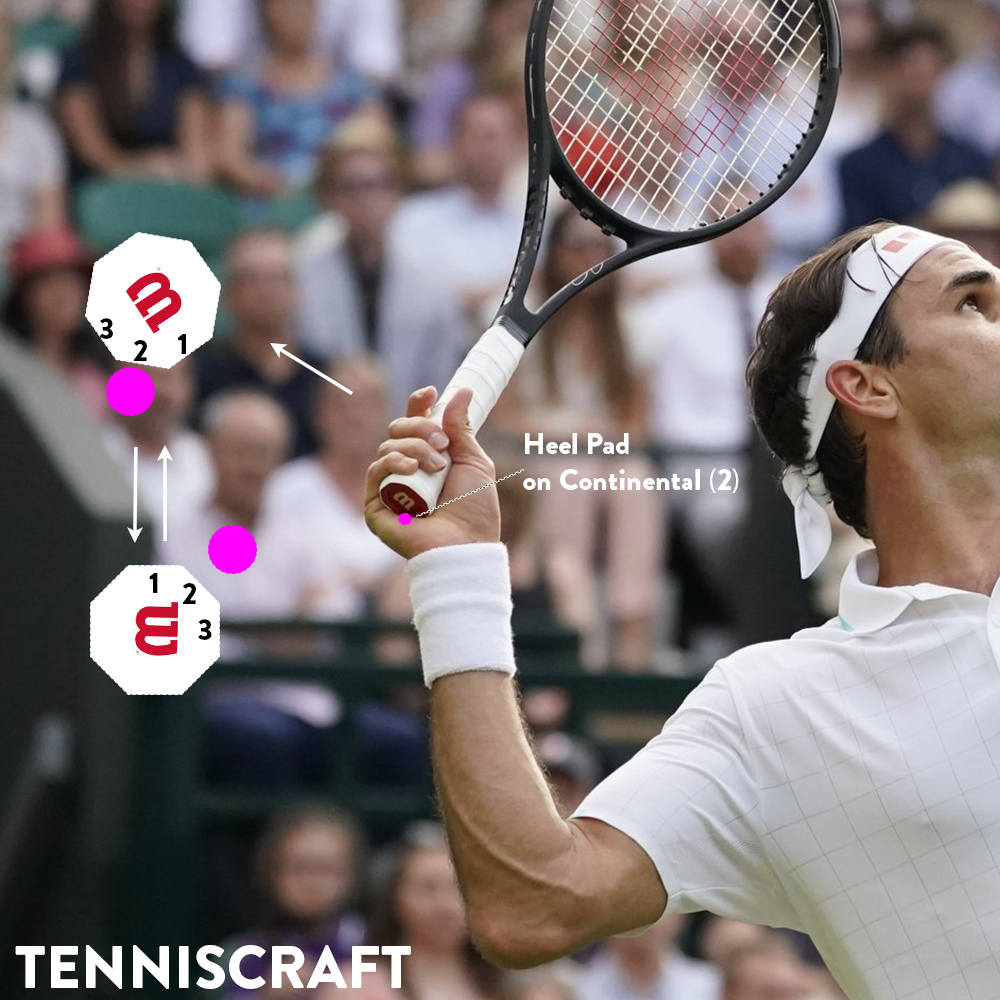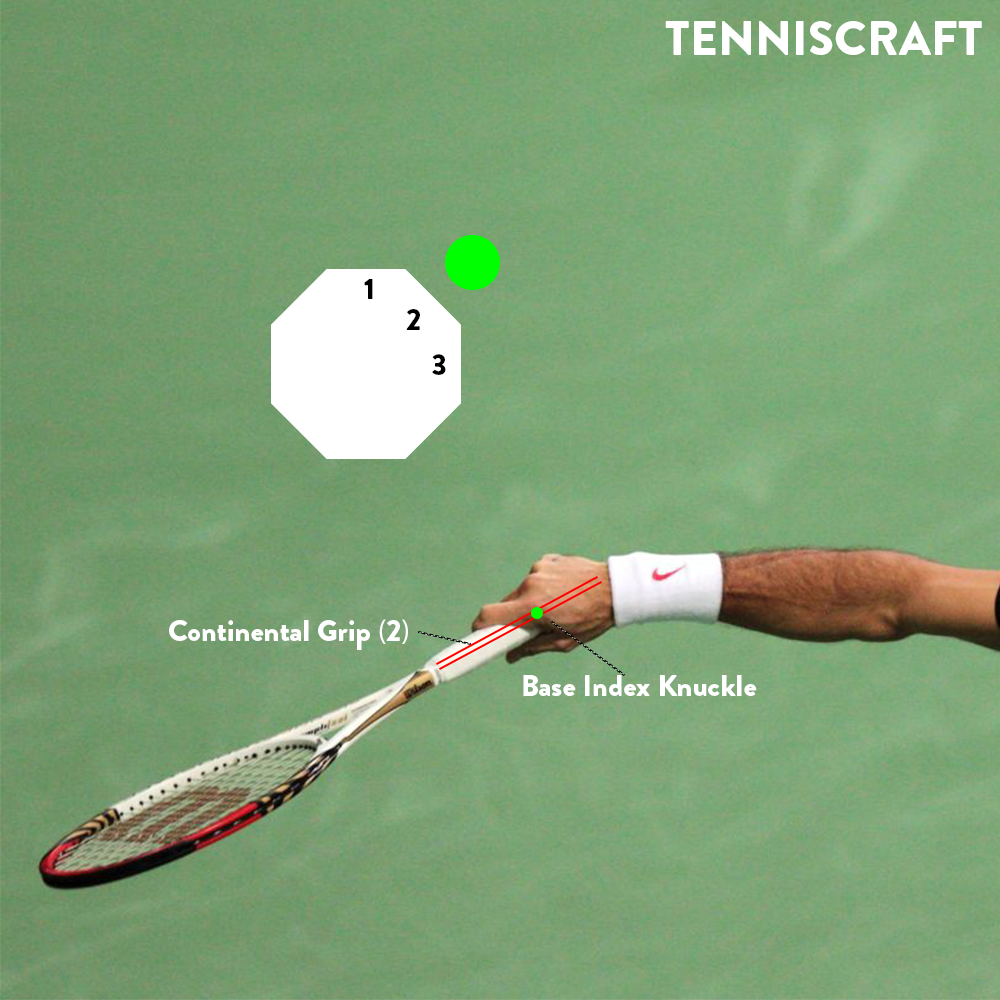Roger Federer Grip Guide, Illustrated
The base index knuckle determines grip, the heel pad helps understand alignment of hand on grip.
You are looking towards the racket butt with the racket being vertical. Each edge of the octagon is a “bevel”.
The most important thing when we are looking to identify a grip, is the BASE index knuckle. So not the top of the knuckle, but under the index knuckle, almost like its belly . Most of the time only the TOP index knuckle is exposed, so you have to visualize where the bottom of the knuckle is going to be.
The heel pad is secondary, and helps understand the hand alignment more exactly. As a player, it’s more important that you focus on the index knuckle, and let the rest of the hand fall naturally in place.
If you are completely unfamiliar with how grips are determined, check my forehand grip guide, which will give you an introduction to the bevel system we use in tennis.
FOREHAND GRIP
Modified Eastern Grip
Index Knuckle on Bevel 3 (Eastern), bordering Bevel 4 (Semi-Western).
Heel Pad on Bevel 4 (Semi-Western), bordering Bevel 3 (Eastern).
Roger Federer’s grip perfectly reflects how his game is a hybrid of modern and traditional tennis. If there was an in between grip of Eastern and Semi-Western this would be it.
Baseline Forehand, AO 2020: You can see how the index knuckle is on the very edge of bevel 3, right before the semi-western grip. This is the typical forehand grip that Roger will employ for most situations. Image Credit: Rob Keating
Baseline Forehand, Wimbledon 2013: Another clean angle of the index knuckle for Federer’s forehand. Reminder to look for where the base index knuckle makes contact with the grip, not where the top index is (which can often be misleading due to perspective)
Baseline Forehand, Italian Open 2015: Here, we have a better view of the Heel Pad which is on Bevel 4. Also notice how much palm is exposed- Roger doesn’t hold the bottom of the grip perfectly aligned at the base of his hand. Just a small detail that may give him a little bit of extra reach and leverage. Image Credit: Tatiana
BACKHAND GRIP
Eastern Backhand
Base Index Knuckle & Heel Pad on Bevel 1
*Not to be confused with the eastern forehand grip.
Backhand, Wilson Promotional 2019: While the source of this photo is from a promotional photo shoot, it gives a very clear perspective of his grip with both continental and eastern backhand bevels in view.
This angle at the end of the swing path gives us the best angle to see the heel pad. I’ve helped reorient the bevels to a normal perspective to see how it sits on Bevel 1 (Eastern backhand).
Backhand, RG 2005: In this picture, you are looking directly at bevel 2 & 3. The red lines highlighting bevel 2, are not the top bevel, but a diagonal one. You can tell his index knuckle doesn’t reach bevel 2, and sits on the top of bevel 1 (Eastern Backhand).
Image Credit: Srdjan Suki
The Eastern Backhand grip is located on bevel 1, and is located “behind” continental (bevel 2). Do not confuse this with the eastern forehand grip which is located on bevel 3. They are completely different grips. They probably share the “eastern” descriptor because they are the closest bevels to continental. The more you stray from continental, the more “western” it becomes.
This is speculation, but it fairly common for “traditional” one-handers to just hit shots on whatever grip they are waiting on, typically continental or very conservative eastern. It’s not so much intentional but more of a reflex shot and getting it done with whatever grip you are on. Federer stays on a very conservative eastern/continental on defense so it wouldn’t be too strange to see him hit a backhand on that grip on instinct.
SLICE GRIPS
Continental
Base index knuckle on Bevel 2 for both forehand & backhand slices
BACKHAND SLICE
Chip Return, Rome 2016: This is a nice angle from behind the BH slice. Be careful of the perspective- when we look at the octagon bevels, I am reorienting it to the players perspective. Bevel 2 is hidden on the other side of the racket. The blue lines illustrate bevel 1 - you can tell that Roger’s index knuckle is just ahead of it, on bevel 2.
Source: Jacky Cheong
Backhand Slice US Open 2019: As opposed to the last picture, this is a front view of the slice. Bevel 2, this time, is in view. Remember we are looking for where the “base” index knuckle is, not where the top of knuckles are.
FOREHAND SLICE
For this photo, I’ve included both the naked picture as well as the marked up graphic. In my opinion, it’s a little easier to eyeball it without the guidelines because the index knuckle is hiding behind the grip.
FH defensive slice, 2019 Wimbledon
The index knuckle and heel pad marked are on the opposite side of the grip on bevel 2. Bevel 7 is what we see directly in the picture
READY POSITION / RETURN GRIPS
Regular Forehand Grip on offense, cross court forehands
Base Index Knuckle on Eastern (3), bordering Semi-Western (4).
Heel pad on Semi-Western (4)
In defensive positions and returns
*Base Index Knuckle on Eastern (3), bordering Continental (2)
Ready Position, Return of Serve. My initial guess was a continental grip, but after drawing the lines along with the rest of my research, my final conclusion is an eastern grip bordering continental.
Practice at Wimbledon 2018: This resolution is too low for zoom in, but you can easily eye ball his forehand eastern grip right at the edge of semi-western. What’s interesting about this picture is that he is clearly moving to a backhand shot, but he is still on his forehand grip. This at least points to the conclusion that he waits in his forehand grip in certain situations.
Image Credit: Matthew Stockman.
This is probably the most definitive photo of Federer’s return grip. Here he is about to return a serve from Nalbandian in the semi finals of Rome.
Source: Rome SF 2006, Stephen Bisgrove
Practice Dubai 2016: Again, too low resolution to zoom, but you can easily eye ball his normal forehand grip. This time Roger is in return position, so if he’s waiting on his forehand grip he mostly definitely is looking at a second serve and moving out of his backhand.
As a player that hunts for his forehand, Roger wants to be waiting on the forehand grip as much as possible. However, tennis is a game of offense and defense, and as most fans know, opponents have historically targeted his backhand as much as possible. While changing from Bevel 3 to bevel 1 isn’t that bad most of the time, it’s too time consuming in super fast paced situations.
On offense and forehand cross courts, he will wait with the forehand grip. On defensive positions such as returns of 1st serves, he’s going to be on a conservative eastern close to continental grip for easy access to slices.
*It’s worth noting that prior to this article, I'd had always assumed he was waiting at continental on defensive ready position. In fact some of photos seem very, very close. After going through the photos and the research to write this article, my personal conclusion is that it’s a conservative eastern bordering continental on defense.
VOLLEY GRIPS
Continental Grip
Base index knuckle Grip on Bevel 2
BACKHAND VOLLEY
A low backhand volley right at the service line during the 2009 Kooyong Classic in Melbourne, Australia.
Source: Quinn Rooney, Getty Images
FOREHAND VOLLEY
Normally I show both boundaries of continental grip, but this angle doesn’t really show much of the continental grip. You can tell that the index knuckle is above the eastern grip at bevel 2.
SERVE & OVERHEAD GRIPS
Continental Grip
Base Index Knuckle on Bevel 2
Heel Pad on Bevel 2 — slipping down to bevel 3 during certain parts of the wind up
Serve, Wimbledon 2020: Unfortunately can’t find a picture of the very beginning of the wind up. This is still near the beginning of the wind up. The base index knuckle is very clearly on continental. What’s interesting is that you can eye ball that the heel grip is beginning to slip down to bevel 3, because of how loose wrists are.
Overhead, Wimbledon 2020: As standard across all professionals, the overhead will share the same grip as the serve. This perspective gives us a good view of the heel pad.
Roger serving near the beginning of his wind up at the Rotterdam 2012 SF.
Continental grip is standard across every pro, but what may be interesting is that you can tell that the heel pad slips down to eastern in certain parts of the wind up. This typically happens when your wrist is very loose— a well-known hallmark of Federer’s technique. In the first two pictures, the heel pad is slipping down to eastern. In the overhead picture, his heel pad is still on continental. Just don’t force the heel pad positioning and don’t overthink it. It just slips when the wrist is loose.
